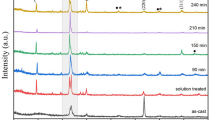Abstract
Four common AlSiMg foundry alloys have been solution heat treated at 813 K, quenched, and immediately aged at 423 K for up to 240 minutes. The mechanical properties are found to be related to the amount of Mg and Si in the alloys. A high strength is obtained after only 60 minutes of solution heat treatment, indicating that the solid solution is rapidly saturated on Mg and Si. The ductility is very much related to the amount of silicon present and the refinement of the silicon crystals within the eutectic areas, since silicon crystals are observed to crack when load is applied. Thus, a well-modified structure is the best way to obtain high ductility. Reduced quencing rates after solution heat treatment lead to a lower strength, since a lower number of hardening β′-Mg2Si precipitates are formed. The ductility of alloys with 0.6 wt pct Mg is increased with a reduced quenching rate. A more ductile matrix corresponding to the lower amount of hardening precipitates can explain this. Alloys with 0.2 wt pct Mg remain relatively unchanged. A hypothesis that may explain this phenomenon is the precipitation of brittle silicon or formation of coarse Mg2Si within the dendrites.
Similar content being viewed by others
References
M. Ravi, U.T.S. Pillai, B.C. Pai, A.D. Damodaran, and E.S. Dwarakadasa: Int. J. Cast Met. Res., 1998, vol. 11, pp. 113–25.
K.T. Kashyap, S. Murali, K.S. Raman, and K.S.S. Murthy: Mater. Sci. Technol., 1993, vol. 9, pp. 189–203.
T.S. Shih and K.S. Shih: Int. J. Cast Met. Res., 1998, vol. 10, pp. 273–82.
Annual Book of ASTM Standards, ASTM E-716, ASTM, Philadelphia, PA, 1997.
J. Stewart: Private communication, internet address: http://metallography.aasp.net, 1999.
D. Apelian, S. Shivkumar, and G. Sigworth: AFS Trans., 1989, pp. 727–41.
P.A. Romctsch, L. Arnberg, and D.L. Zhang: Int. J. Cast Met. Res., 1999, in press.
G.W. Powell: Mater. Characterization, 1994, pp. 275–93.
M. Lebyodkin, A. Deschamps, and Y. Bréchet: Mater. Sci. Eng., 1997, pp. 481–84.
G.W. Lorimer and R.B. Nicholson: The Mechanism of Phase Transformations in Crystalline Solids (Conf. Proc.), 1968, pp. 36–42.
C. Panseri, T. Federighi, and S. Ceresara: Trans. TMS-AIME, 1963, vol. 227, pp. 1122–27.
M. Kaczorowski: Aluminium, 1985, vol. 10, pp. 756–62.
I. Kovács, J. Lendvai, and E. Nagy: Acta Metall., 1972, vol. 20, pp. 975–83.
S. Ceresara, E. Di Russio, P. Fiorini, and A. Giarda: Mater. Sci. Eng., 1969–70, pp. 220–27.
A.L. Dons, L. Pedersen, and L. Arnberg: Mater. Sci. Eng., 1999, in press.
D.L. Zhang and L. Zheng: Metall. Mater. Trans. A., 1996, vol. 27A, pp. 3983–91.
G. Gustafsson, Y. Thorvaldsson, and G.L. Dunlop: Metall. Trans. A, 1986, vol. 17A, pp. 45–52.
Author information
Authors and Affiliations
Rights and permissions
About this article
Cite this article
Pedersen, L., Arnberg, L. The effect of solution heat treatment and quenching rates on mechanical properties and microstructures in AlSiMg foundry alloys. Metall Mater Trans A 32, 525–532 (2001). https://doi.org/10.1007/s11661-001-0069-y
Received:
Issue Date:
DOI: https://doi.org/10.1007/s11661-001-0069-y




